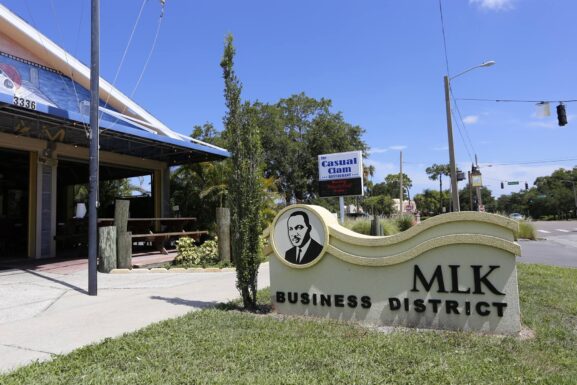St. Petersburg’s MLK, 8th streets could become two-way. Will they be safer?
Two of downtown St. Petersburg’s busiest drags — Eighth Street and Dr. Martin Luther King Jr. Street — are closer to becoming two-way after the city secured a federal grant last week.
Transportation leaders and advocates see plenty of benefits. Two-way streets are thought to slow the flow of traffic rushing to and from downtown, preventing crashes and pedestrian deaths. A redesign of the streets could allow wider sidewalks, bike lanes and on-street parking, bringing pedestrians to roadside businesses, said Whit Blanton, executive director of Forward Pinellas, the county transportation planning agency.
The changes could also help reconnect neighborhoods south of Tropicana Field that were blocked off from downtown by the 1970s construction of the Interstate 175 interchange and the advent of one-way streets, Mayor Ken Welch said.
“Streets are public spaces where people gather,” Blanton said. “But most of the way we’ve designed our streets, they’re more like a traffic sewer than anything else.”
Shawn Hannan, president of the MLK Business District, said his organization was founded in the 1990s to advocate for converting Eighth and MLK streets. Two-way traffic theoretically means twice as much visibility for his members, he said.
“With a lot of things changing in the city, with the growth of the MLK corridor, this is probably the time that it makes sense to get the ball rolling on this,” he said.
The city has been vying for federal dollars to convert the two downtown streets since 2023. The nearly $1.4 million it has received from the Department of Transportation will fund the design of the two reconceived thoroughfares. Blanton suspects that process could take between a year and 18 months. The city will need to compete for more funds before construction can begin.
That means drivers, pedestrians and business owners could be years from reaping the benefits of the reconfigured roads.
How one-way streets increase crash risks
Justin Cournoyer, a transportation advocate and Campbell Park resident, celebrates the grant as a first step toward a safer downtown St. Petersburg.
Cournoyer doesn’t own a car. Right now, his walks to Publix along MLK Street are perilous, with narrow sidewalks, few crosswalks and little buffer between him and cars whistling past at up to 60 miles per hour (well over the legal speed limit).
A 2022 study by Forward Pinellas found that downtown St. Petersburg’s one-way streets accounted for nearly half of car crashes in the area between 2015 and 2019. On Eighth and MLK streets, around 25 of some 600 crashes in those four years were fatal or incapacitating.
One-way roads generally allow cars to travel at higher speeds, Blanton said, increasing the risk of fatal crashes. St. Petersburg’s one-way drags are bygones of late-20th century planning, he said, that prioritized commuters over downtown residents and pedestrians.
More changes in store for downtown roads
Converting Eighth and MLK streets is just the beginning for St. Petersburg.
The city’s downtown mobility plan, a strategy to service future growth and improve safety, outlines two more priorities. One is converting two more downtown one-way roads: Third and Fourth streets, which are maintained by the Florida Department of Transportation. The state agency has signaled willingness to change those streets to two-way and sell them to the city in the next few years, Blanton said.
The last prong of the plan is a “biggie,” Blanton said. Florida’s transportation agency is kicking off a study next month on how to reconfigure I-175, which connects city streets to the major I-275 highway from the south side of downtown, to meet current community needs.
The interstate’s 1970s construction has been called a “colossal mistake” by U.S. Rep. Kathy Castor, who helped secure the city’s grant. To Cournoyer, it’s a monument to the city’s history of racial injustice, when 4,000 residents, more than half of them Black, were forced to move to make way for the interstate.
Cournoyer is founder of Reimagine 175, which advocates for tearing down the highway and replacing it with a street-level boulevard. The move could make way for more housing and business development, he said.
Eliminating I-175 altogether faces a few political hurdles, Blanton said. The state transportation agency and the Federal Highway Administration, which arereluctant to change the country’s interstate system, would have to sign off. Another option would decrease the size of I-175 and potentially encourage development underneath it.
There’s a general sense something has to change, Blanton said.
“I think the community to the south of the interstate really feels like it’s just been such a barrier,” he said. “Visibly, it’s a barrier. Perceptually, it’s a barrier. It’s hindered economic development, access to jobs, and it just feels like they are not welcome to participate in the benefits of being in the city of St Petersburg.”

